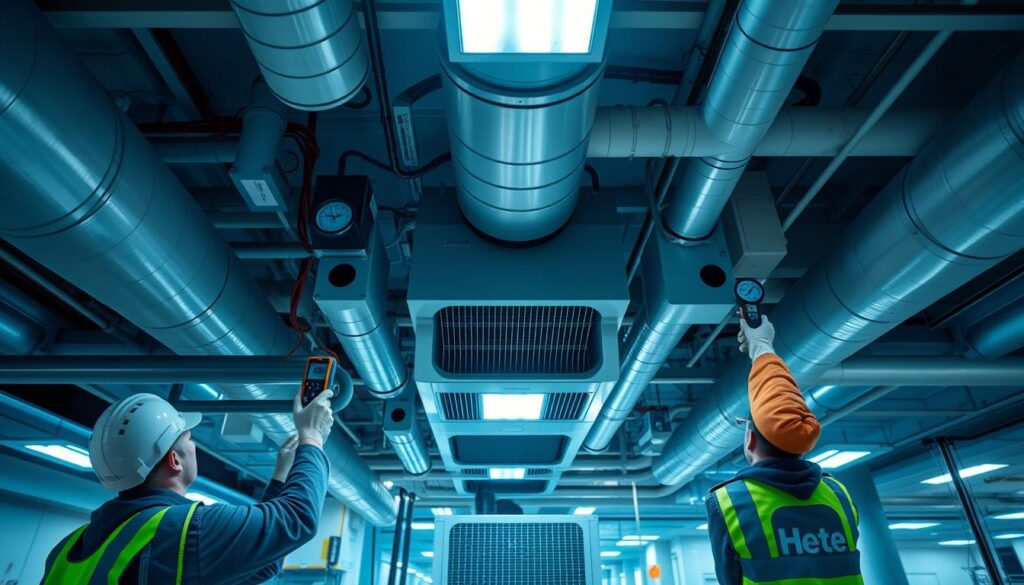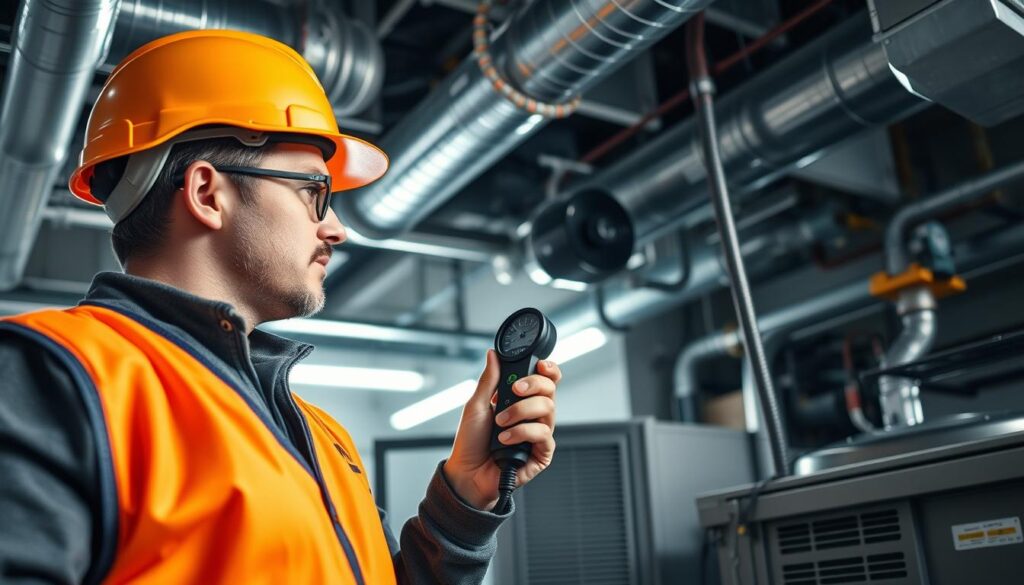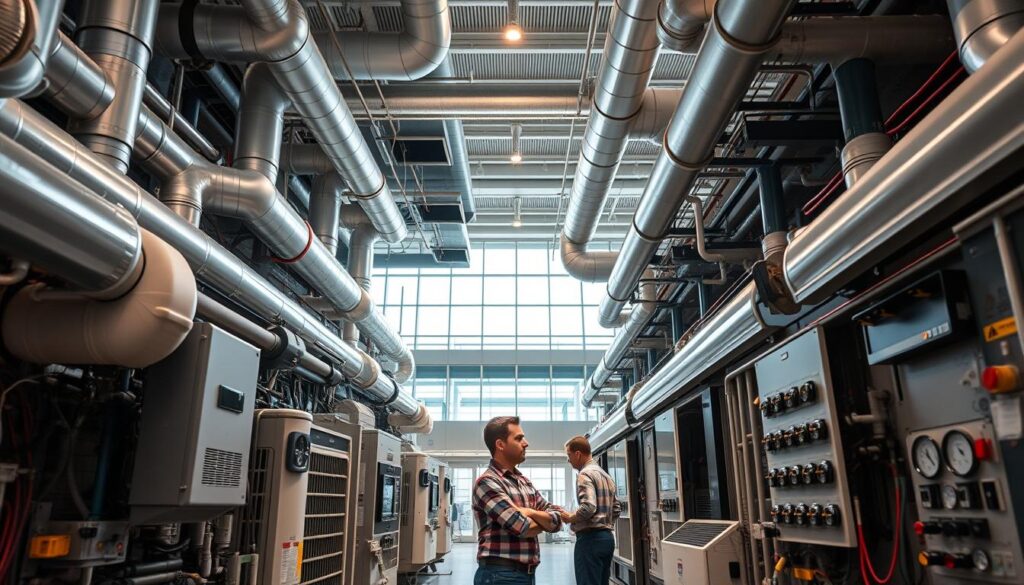Affiliate Disclosure
HVAC Guide Guys is a participant in the Amazon Services LLC Associates Program, an affiliate advertising program designed to provide a means for sites to earn advertising fees by advertising and linking to Amazon.
How to Balance a Commercial HVAC System? Is your HVAC system costing you thousands of dollars each year? Using commercial HVAC balancing techniques can change that. It can make your building more efficient, cut down on energy costs, and make it more comfortable.

But balancing a commercial HVAC system is more than just tweaking vents. It’s a detailed process that makes sure air flows right, saves energy, and keeps equipment running long. Experts use special methods to check and fine-tune these complex systems.
To master balancing a commercial HVAC system, you need technical skills and a smart plan. Building managers and engineers must get the hang of airflow, temperature control, and system dynamics. This is how they reach the best performance.
Key Takeaways
- Proper HVAC balancing reduces energy consumption
- Improves indoor air quality and comfort levels
- Extends equipment lifespan
- Minimizes temperature variations across building zones
- Prevents unnecessary wear on HVAC components
Table of Contents
Understanding Commercial HVAC System Balancing Fundamentals
Air balancing is key in commercial HVAC systems for top performance and comfort. It’s like tuning a musical instrument, where each part is vital for harmony.
The air balancing process for commercial buildings involves making precise adjustments. These ensure an efficient and comfortable indoor space. Your HVAC system’s success depends on how well it distributes air.
Key Components of HVAC System Balance
Commercial air distribution balancing focuses on several critical parts:
- Dampers that control airflow
- Ventilation systems
- Ductwork design
- Air handling units
- Temperature sensors
Importance of Proper Air Distribution
Proper air distribution is more than just controlling temperature. It affects:
- Indoor air quality
- Energy efficiency
- Occupant comfort
- Equipment longevity
Impact on Building Performance
A balanced HVAC system can cut energy use by up to 30%. It removes hot and cold spots, ensures even temperatures, and boosts comfort for occupants.
Effective air balancing is like creating a perfectly choreographed dance of air movement within your commercial space.
Knowing these basics helps you improve your commercial HVAC system’s performance and efficiency.
Explore Our HVAC Shop
Looking for top-rated HVAC tools, parts, and accessories? Visit our shop and find the perfect solution for your needs.
Visit the ShopEssential Tools and Equipment for HVAC Balancing
Professional HVAC system testing and balancing need special tools. These tools help technicians get exact measurements and the best performance. They use advanced tools to check airflow, temperature, and system efficiency.
Key tools for HVAC system testing and balancing include:
- Anemometers: Measure air velocity and volume with exceptional precision
- Digital manometers: Detect static pressure variations in ductwork
- Infrared thermography cameras: Visualize temperature distributions and detect thermal irregularities
- Airflow meters: Quantify air movement through ventilation systems
Modern technology has changed HVAC practices. New digital tools give real-time data. This lets technicians adjust systems right away for better performance.
“The right tools are essential for maintaining peak HVAC system efficiency and comfort.” – HVAC Engineering Professionals Association
Choosing the right equipment for HVAC testing is important. Professionals look at accuracy, calibration, and system compatibility. Using top-notch tools means better system analysis and long-term success.
Explore Our HVAC Shop
Looking for top-rated HVAC tools, parts, and accessories? Visit our shop and find the perfect solution for your needs.
Visit the ShopPre-Balancing System Inspection and Documentation
Getting ready for commercial ventilation balancing needs careful planning and detailed records. Before you start improving commercial HVAC airflow, a detailed pre-balancing check is key. It ensures your system works well and efficiently.
Gathering System Documentation
Having the right documents is the first step to successful commercial ventilation balancing. You’ll need to gather several important documents:
- Original mechanical design drawings
- Equipment manufacturer specifications
- Previous maintenance records
- Architectural building plans
- Control system schematics
Creating Baseline Measurements
Getting baseline measurements is vital for HVAC system improvement. These initial readings show how well your system works now. They also help you see how much better it gets during balancing.
| Measurement Type | Purpose | Recommended Tools |
|---|---|---|
| Airflow Rates | Determine current air distribution | Anemometer |
| Static Pressure | Assess ductwork resistance | Digital manometer |
| Temperature Differentials | Evaluate system efficiency | Infrared thermometer |
Initial System Assessment Checklist
Before you start improving commercial HVAC airflow, use this checklist for a complete pre-balancing check:
- Verify all ductwork is properly sealed
- Check for obstructions in air pathways
- Inspect filter conditions
- Examine damper functionality
- Test control system responsiveness
Pro Tip: Detailed documentation and accurate baseline measurements are the keys to successful commercial ventilation balancing.
How to Balance a Commercial HVAC System
Balancing a commercial HVAC system needs a careful plan for the best performance and energy use. To start, follow a series of steps to improve air flow and system work.

- Conduct initial airflow measurements
- Identify potential air distribution issues
- Adjust dampers and vents precisely
- Verify system performance
First, collect all system details. This includes blueprints, original plans, and current setup. Accurate measurements are key to spotting airflow problems and finding solutions.
Important techniques for balancing include:
- Static pressure testing to check system resistance
- Measuring temperature differences in zones
- Looking at ductwork for blockages
Experts use tools like digital manometers and airflow hoods for precise checks. These tools help find where to make changes for better system performance.
Successful HVAC balancing requires patience, precision, and a systematic approach to air distribution optimization.
Explore Our HVAC Shop
Looking for top-rated HVAC tools, parts, and accessories? Visit our shop and find the perfect solution for your needs.
Visit the ShopMeasuring and Adjusting Airflow Parameters
Getting precise is key in air balancing for commercial buildings. Knowing how to measure and tweak airflow is vital for your HVAC’s best performance. HVAC experts use special methods that go beyond simple checks.
Technicians use advanced ways to analyze airflow. They collect detailed data on how well the system works. This helps spot problems and make the system better.
Static Pressure Testing Methods
Static pressure tests are crucial for HVAC system checks. Experts use special tools to measure air pressure in ducts. This helps find any blockages or inefficiencies.
- Utilize digital manometers for accurate readings
- Compare measured pressures against design specifications
- Identify potential blockages or airflow constraints
Duct Traverse Measurements
Duct traverse tests give a full picture of airflow. By taking readings at various duct points, technicians map out air flow patterns.
| Measurement Tool | Purpose | Accuracy Level |
|---|---|---|
| Vane Anemometer | Measure air velocity | High |
| Pitot Tube | Determine volumetric airflow | Very High |
| Thermal Anemometer | Detect low-speed air movement | Medium |
Temperature Differential Analysis
Temperature differential analysis checks heating and cooling efficiency. It measures temperature differences between supply and return air. This helps see how well the system is working and where it can get better.
For accurate air balancing, a mix of methods is needed. This ensures your HVAC system works its best.
Advanced Balancing Techniques for Commercial Buildings

Professional HVAC commissioning has changed how commercial buildings handle their air systems. Now, advanced techniques use the latest technology to improve building performance and save energy.
These new methods go beyond simple manual tweaks:
- Computer modeling and simulation software
- Infrared thermography diagnostics
- Automated real-time balancing systems
- Predictive performance analytics
Digital tools help engineers predict airflow with great accuracy. These advanced software platforms can simulate complex HVAC situations. They spot potential problems before they need to be fixed.
“Technology has transformed HVAC balancing from reactive maintenance to proactive optimization.” – HVAC Engineering Quarterly
Infrared thermal imaging is another big step forward. It shows temperature changes and finds air leaks that old methods might miss.
Automated balancing systems are the top of the line in HVAC management. They watch the environment and adjust in real-time. This keeps the building comfortable and energy-efficient.
Explore Our HVAC Shop
Looking for top-rated HVAC tools, parts, and accessories? Visit our shop and find the perfect solution for your needs.
Visit the ShopTesting and Adjusting Balance Dampers
Commercial air distribution balancing is all about managing balance dampers. These parts are key to controlling air flow in your HVAC system. They help keep your system running efficiently and consistently.
Adjusting damper positions needs careful attention and a systematic approach. Your aim is to ensure even air flow across your commercial space.
Damper Position Optimization
To optimize damper positions, follow these steps:
- Start with outlets farthest from the air handler
- Make incremental adjustments
- Measure airflow after each modification
- Verify temperature consistency across zones
Airflow Pattern Analysis
Understanding airflow patterns is key to spotting issues. Use specialized tools to map and analyze air movement in your commercial HVAC system.
System Resistance Evaluation
Evaluating system resistance is vital for balanced airflow. Consider these factors:
- Duct configuration
- Filter conditions
- Equipment efficiency
- Potential blockages
Professional tip: Regular maintenance and precise damper adjustments can significantly improve your HVAC system’s overall performance and energy efficiency.
Thermostat Calibration and Zone Control
Getting your commercial ventilation to work right needs precise thermostat settings and smart zone control. Your HVAC system’s performance depends on accurate temperature readings. It also needs smart air distribution across different areas of the building.
It’s key to calibrate your thermostat right for consistent comfort and energy savings in commercial spaces. If your temperature sensors are off, it can put a lot of stress on your HVAC system.
- Check thermostat placement away from direct sunlight or heat sources
- Verify sensor accuracy using professional-grade thermometers
- Calibrate digital thermostats annually
- Ensure proper electrical connections
Zone control systems manage temperature by dividing your space into separate areas. This lets you set different temperatures for each area, saving energy and improving comfort.
| Zone Control Feature | Performance Benefit |
|---|---|
| Multi-zone damper system | Precise airflow regulation |
| Individual temperature sensors | Targeted climate control |
| Smart zone management | Energy efficiency optimization |
When balancing commercial ventilation, think about what each zone needs. Restaurants, offices, and storage areas all have their own temperature and airflow needs.
Effective zone control turns your HVAC system into a precise climate management tool.
Common Balancing Challenges and Solutions
When working on HVAC systems, technicians often run into big challenges. These can really affect how well the system works. Knowing about these common problems is key to fixing them.
The biggest issues technicians deal with include:
- Insufficient total airflow across different zones
- Uneven temperature distribution
- Unexpected system noise after balancing
- Pressure imbalances between rooms
To solve these problems, a step-by-step plan is needed. First, check the basics of the system:
- Inspect air filters for debris and blockages
- Verify fan speed settings and motor performance
- Check ductwork for potential leakage points
- Evaluate return air paths for obstructions
Pro tip: Not all balancing challenges require expensive repairs. Often, simple adjustments can significantly improve HVAC system performance.
When problems get tough, experts might be needed. Certified HVAC technicians use special tools to find and fix complex issues.
By knowing these common problems and using the right fixes, you can make your commercial HVAC system work better. This means better comfort and energy use.
Explore Our HVAC Shop
Looking for top-rated HVAC tools, parts, and accessories? Visit our shop and find the perfect solution for your needs.
Visit the ShopDocumenting and Verifying Balance Results
Professional HVAC commissioning needs careful documentation. This ensures the air balancing in commercial buildings is precise and effective. The last steps of balancing your HVAC system are key for its long-term performance and upkeep.
Getting detailed results involves several important steps. These steps confirm your HVAC commissioning work:
Final Measurement Recording
Your records should have all the system’s performance details. Make a plan to record measurements:
- Airflow rates for each zone
- Temperature differentials
- Static pressure readings
- Equipment performance metrics
Performance Verification Steps
“Accurate documentation is the blueprint of system excellence.” – HVAC Engineering Professionals
Check system performance with thorough tests. These tests show if the air balancing in commercial buildings was done right:
- Cross-check measured values against design specs
- Check temperature consistency across zones
- Look at energy efficiency
- Make sure the system meets standards
System Balance Report Creation
Make a detailed report for future maintenance and upgrades. Your report should have:
- Detailed measurement logs
- Summary of performance evaluation
- Improvement suggestions
- Baseline data for future comparisons
By sticking to these documentation steps, you meet top industry standards. You get a clear record of system performance and possible ways to improve.
Conclusion
Learning how to balance commercial HVAC systems is key to a comfortable and efficient building. Your HVAC system is a big investment. Proper balancing helps you get the most out of it, saving energy and extending its life.
Professional HVAC balancing is more than just upkeep. It involves detailed checks and tweaks to airflow. This can cut down energy use, improve air quality, and make your systems last longer. It’s complex work that needs experts who know how to fine-tune systems.
Regular checks and fine-tuning of your HVAC system can prevent breakdowns and save on repairs. It keeps your space comfortable all the time. Seeing HVAC balancing as a maintenance task is short-sighted. It’s really about managing your building’s environment wisely.
Optimizing commercial HVAC airflow is a continuous effort. With the right balancing methods and regular checks by pros, your system will run smoothly. This ensures top performance and efficiency for years to come.

